
The Complete Guide to Rulers with Increments
Understanding Measurement Precision
A ruler with increments is a measuring tool marked with regular divisions for taking accurate measurements. These tools come in various types with different increment systems to meet specific needs.
| Ruler Type | Common Increments | Best For |
|---|---|---|
| Standard School Ruler | 1/8" or 1/16" | General classroom use |
| Machinist's Ruler | 1/32" or 1/64" | Precision metalworking |
| Engineering Ruler | 1/10" decimal divisions | Technical drawing |
| Metric Ruler | 1mm or 0.5mm | Scientific measurement |
| Dual-Scale Ruler | Both imperial and metric | Versatile applications |
A ruler with increments refers to any measuring device with standardized markings that divide the length into equal parts. These increments can range from common fractions like 1/16 inch to precise measurements such as 0.5 millimeters, depending on the ruler's intended purpose.
Most standard rulers feature 1/16-inch increments on the imperial side and millimeter increments on the metric side. However, specialty rulers for engineering, drafting, or machining work may include finer divisions like 1/32-inch, 1/64-inch, or even decimal-based increments of 1/10-inch.
Choosing the right ruler with increments depends entirely on your specific measuring needs. For general household tasks, a basic ruler with 1/8-inch increments may suffice. For precision woodworking or engineering applications, you'll likely need a ruler with much finer increments.
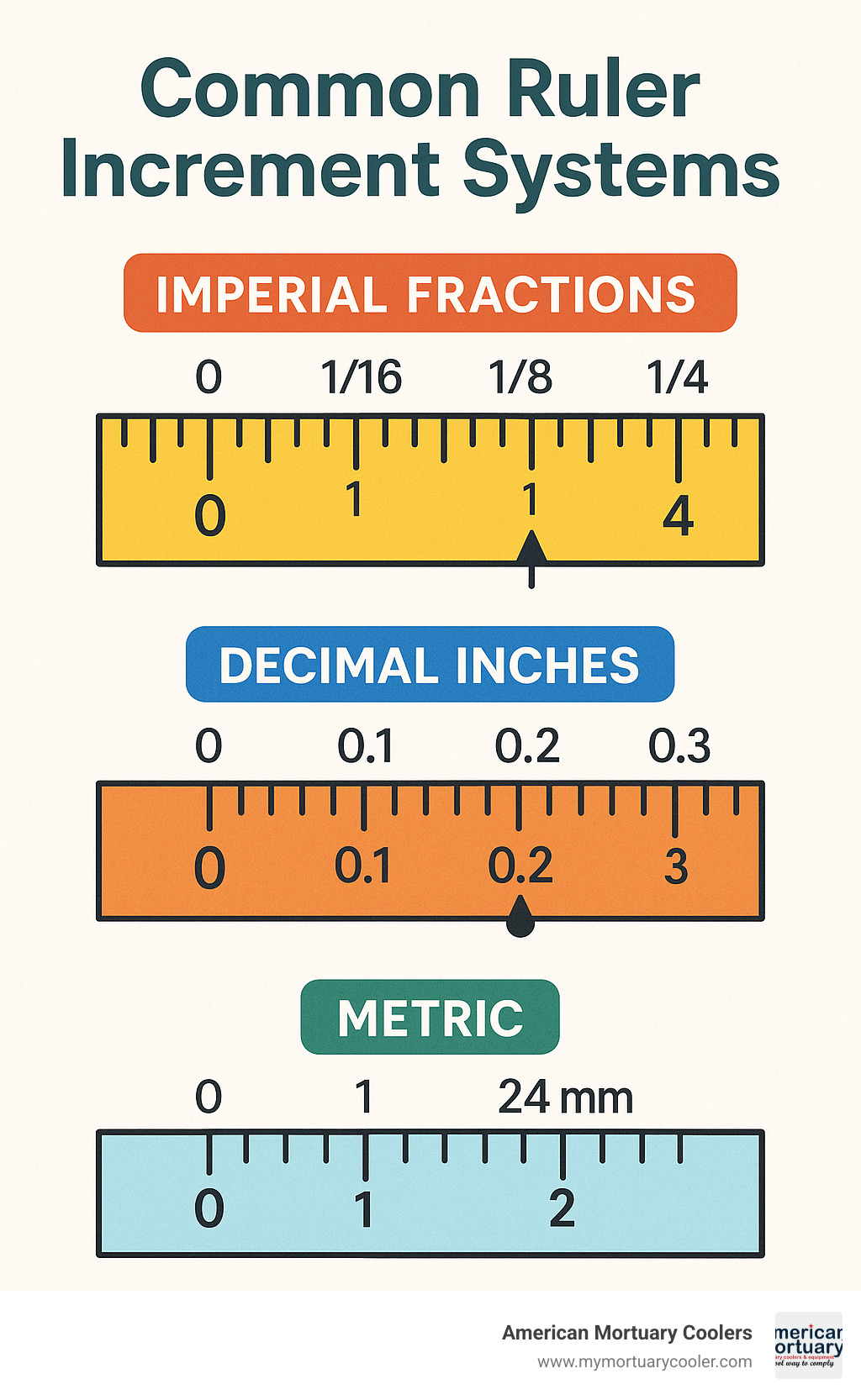
Key terms for ruler with increments:
Understanding Increment Basics
Ever wonder why rulers have all those little lines? Those are increments – the standardized divisions that make precise measurement possible. Think of them as the ruler's language, speaking to you in different dialects depending on whether you're using imperial (inches) or metric (centimeters and millimeters) measurements.
In the imperial world, a typical 12-inch ruler with increments breaks down inches into increasingly smaller fractions. Most commonly, you'll see divisions for half-inch, quarter-inch, eighth-inch, and sixteenth-inch marks. For detailed work, some specialty rulers offer tiny 1/32-inch or ultra-precise 1/64-inch increments.
The metric system takes a different approach. Rather than fractions, it uses a clean decimal system with centimeters (cm) and millimeters (mm). Each centimeter contains exactly 10 millimeters – no complicated fractions needed! Some high-precision metric rulers even feature 0.5mm increments for extreme accuracy.
Fractional vs Decimal Increments
When working in inches, you'll encounter two different philosophies: the traditional fractional approach and the more calculation-friendly decimal system.
Fractional increments divide inches into parts like 1/16 or 1/32. These familiar markings appear on most standard rulers and work wonderfully for woodworking, construction, and crafting projects. A ruler with increments of 1/16-inch provides enough precision for most everyday tasks.
Decimal increments take a completely different approach by dividing inches into tenths (1/10) instead of binary fractions. Engineering scale rulers typically use this system, making each inch contain 10 equal parts. This makes calculations dramatically simpler – 3/10 inch is simply 0.3 inches, and 7/10 inch becomes 0.7 inches.
Your choice between these systems often depends on your specific needs:
- Woodworkers and craftspeople typically prefer fractional increments because they align with traditional building practices
- Engineers and technical drafters gravitate toward decimal increments for easier calculations
- Scientists and healthcare professionals generally opt for metric measurements for universal precision
Metric Subdivisions Explained
The metric system offers a refreshingly straightforward approach to measurement. On a metric ruler with increments, you'll notice two primary division types:
Centimeters (cm) appear as the larger, numbered divisions, while millimeters (mm) show up as the smaller lines between them, with exactly 10 mm making up each centimeter. Most standard metric rulers feature 1mm increments, providing excellent precision for general use.
The true beauty of the metric system lies in its decimal simplicity. Need to convert between units? Just move the decimal point! One centimeter equals 10 millimeters. A measurement of 2.5 cm instantly converts to 25 mm. This straightforward conversion makes calculations much simpler compared to working with imperial fractions.
How to Read a Ruler with Increments
Reading a ruler with increments might seem simple, but mastering this skill takes practice. Whether you're working on a DIY project or handling precise measurements in a laboratory, understanding how to read your ruler correctly is essential for accuracy.
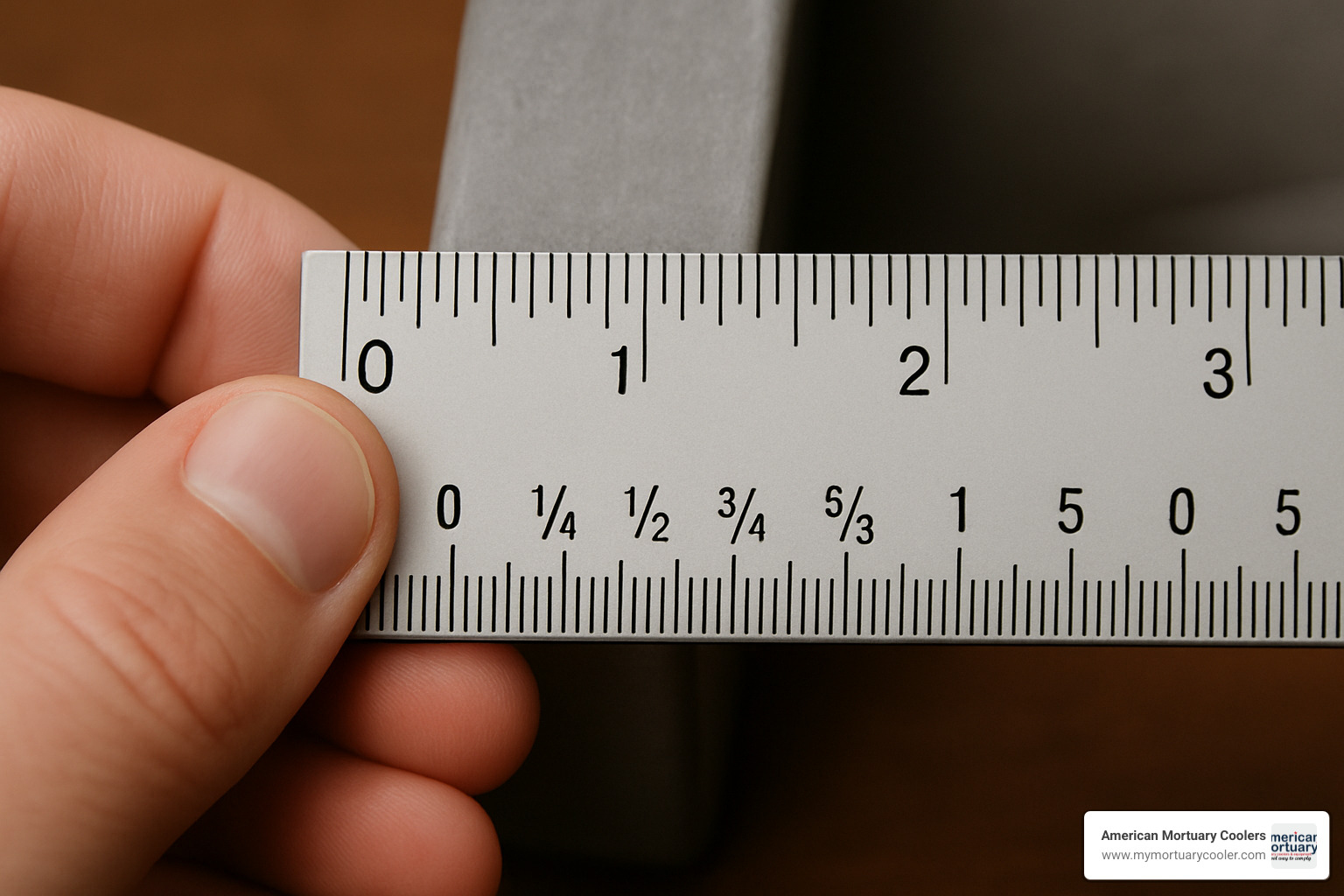
The first step to accurate measurement is proper alignment. Place your ruler so the zero mark sits exactly at the beginning of what you're measuring. You'd be surprised how many measurement errors happen simply because the ruler wasn't lined up correctly!
Most rulers feature what we call a "zero-start" design, where measurements begin right at the edge. However, high-precision rulers might have a small gap before the zero mark to account for wear and tear on the ruler's edge over time.
When reading the marks, there's a method to the madness. On imperial rulers, those longest lines mark whole inches, while the medium-length lines typically show half-inch points. The shorter lines represent increasingly smaller fractions like quarters, eighths, and sixteenths. With metric rulers, the longest lines show centimeters, and those shorter marks between them indicate millimeters.
Step-by-Step: Reading 1/16 and 1/32 on a Ruler with Increments
For 1/16-inch increments, start by identifying the whole inch marks (those longest lines). Between each inch, you'll find the half-inch mark (second longest line). Between those, look for the quarter-inch marks, and between those, you'll see the eighth-inch marks. Finally, the smallest visible lines represent those 1/16-inch increments.
For example, if your pencil mark lands on the third 1/16-inch line after the 2-inch mark, you're looking at a measurement of 2-3/16 inches.
When it comes to the even finer 1/32-inch increments, follow the same process to identify the 1/16-inch marks first. Then, locate those tiny 1/32-inch marks nestled between each 1/16-inch line.
Hands-on practice is essential for mastering these fine increments. Try measuring different objects around your home or workshop to build your skills.
Converting Fractions and Decimals on a Ruler with Increments
Converting between fractions and decimals is something you'll do often when working with measurements. Some clever rulers actually show both fractional and decimal equivalents right on the tool.
Here are some common conversions you'll encounter: 1/4 = 0.25, 1/2 = 0.5, and 3/4 = 0.75. For the less common fractions, simply divide the top number by the bottom number. So 5/16 would be 5 ÷ 16 = 0.3125.
If you're teaching children or just want a handy reference, check out this Printable Decimals and Fractions Ruler. It's a wonderful visual aid that shows both forms side by side.
Dual-Scale Metric/Imperial Ruler Tips
A dual-scale ruler with increments is like getting two tools in one – it features both imperial and metric measurements, typically with imperial on one edge and metric on the other. These versatile rulers are lifesavers when you're working on international projects or with mixed measurement systems.
When using one of these handy dual-scale rulers, consistency is key. Decide which measurement system you're using for your current project and stick with it to avoid confusion.
It's helpful to remember some quick conversions: roughly speaking, 1 inch equals about 2.54 centimeters, and 1 centimeter is approximately 0.39 inches. And the beauty of a dual-scale ruler? When you need to switch between systems, just flip it over!
In laboratory settings like those we outfit at American Mortuary Coolers, dual-scale rulers are particularly valuable. They allow technicians to seamlessly work with both measurement systems – essential when dealing with international standards and equipment. If you're interested in laboratory setups, you might enjoy our article on The Complete Guide to Comparing Laboratory Sink Cabinets.
Materials, Safety Features, and Build Quality
The material and construction of a ruler with increments significantly impact its durability, accuracy, and suitability for different environments. The three most common materials for rulers are wood, plastic, and metal (typically stainless steel).
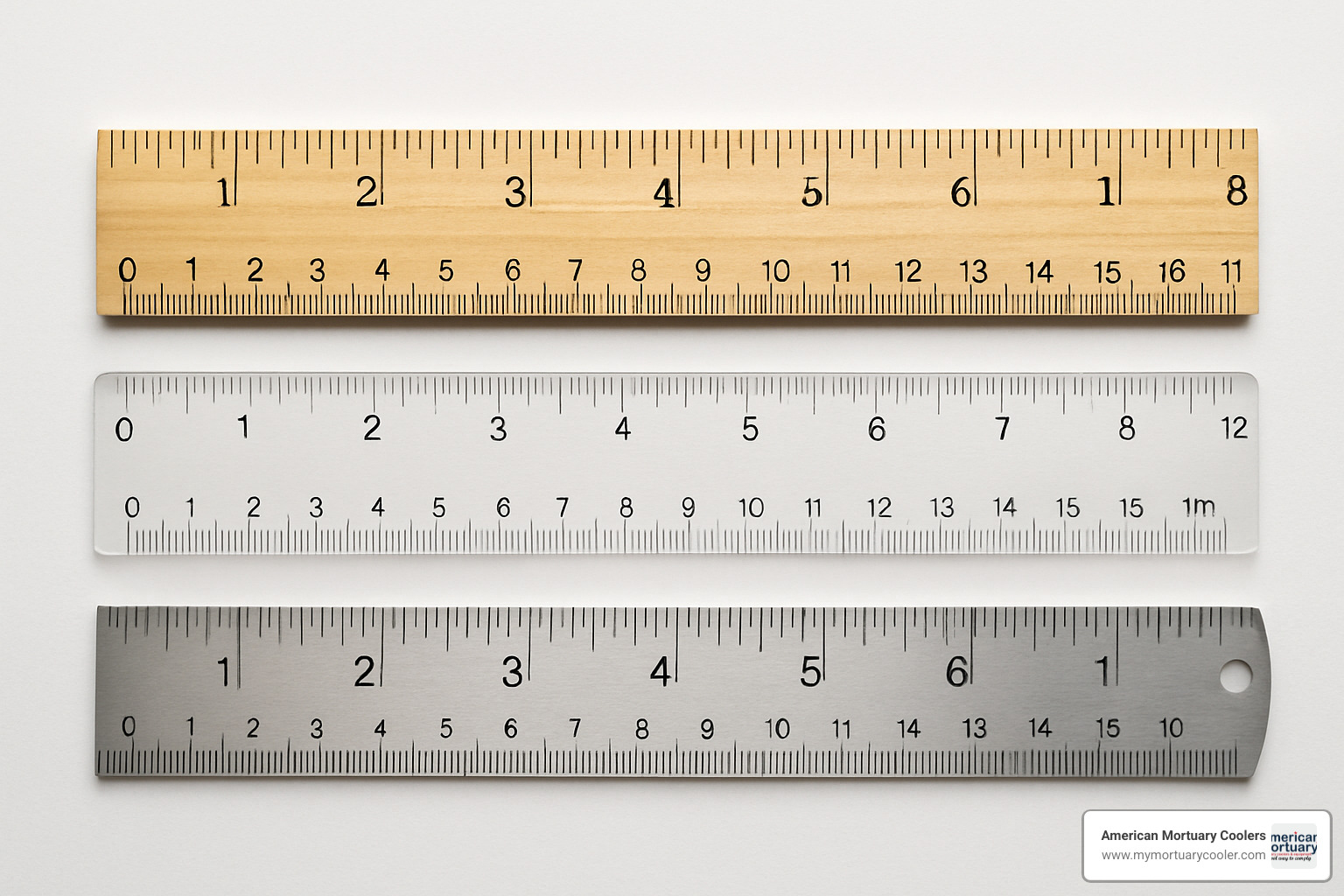
When choosing a ruler, it's not just about the increments—the material matters just as much! Let's look at how different materials stack up:
| Material | Durability | Accuracy | Best For | Price Range |
|---|---|---|---|---|
| Wood | Moderate | Good | Classroom, general use | $1-$5 |
| Plastic | Low to High (depending on quality) | Good | Classroom, office | $1-$10 |
| Stainless Steel | Very High | Excellent | Professional, workshop | $5-$30 |
| Aluminum | High | Very Good | Technical drawing | $10-$25 |
Wood vs Plastic vs Metal Rulers
Wooden rulers offer a natural feel with a comfortable weight. They're typically coated with clear lacquer to protect the surface, but they can warp if left in damp conditions. At $1-$5, they're budget-friendly options perfect for classrooms and casual measuring tasks.
Plastic rulers range from flimsy dollar-store varieties to virtually indestructible professional tools. The better ones are often transparent, letting you see exactly what you're measuring underneath. They're also completely waterproof, making them ideal for environments where moisture might be an issue. Expect to pay anywhere from $1 for basic models to $10 for premium shatterproof versions.
When precision really matters, metal rulers are hard to beat. Made from stainless steel or aluminum, these heavyweight champions provide exceptional accuracy and can last a lifetime with proper care. The etched markings won't rub off, and the edges stay perfectly straight even after years of use. The investment—typically $5-$30—pays off in longevity and reliability.
Safety by Design: Beveled Edges & Shatterproof Plastics
Modern rulers with increments often feature clever safety elements that don't compromise accuracy. Beveled edges serve double duty—they reduce the risk of cuts and allow the ruler to lie perfectly flat on your paper, preventing ink from bleeding underneath when drawing lines.
For classroom settings, shatterproof plastic rulers are a game-changer. Unlike brittle rulers that could snap into dangerous shards, these specially engineered plastics flex under pressure rather than breaking.
The addition of rounded corners prevents accidental puncture injuries—especially important when rulers are carried in backpacks or pockets. These safety considerations make modern rulers both safer and more user-friendly without sacrificing accuracy.
Visibility & Longevity: Etched vs Printed Markings
Etched markings are physically engraved into the ruler's surface. On professional metal rulers, these etchings are typically filled with black enamel for contrast, creating markings that won't wear away even after decades of use. They're impervious to most chemicals and can withstand regular cleaning.
Printed markings are applied to the surface using ink or paint. They're crisp and clear when new, but they're vulnerable to wear, especially along frequently used sections.
Many high-end stainless steel rulers feature a satin finish that reduces glare, a thoughtful touch that makes a big difference when working under bright lights. This non-reflective surface prevents the frustration of shifting your ruler around to avoid light reflections obscuring the measurements.
Choosing the Right Ruler for Every Application
Finding that perfect ruler with increments doesn't have to be a measuring headache! Whether you're crafting a masterpiece or engineering the next big thing, the right ruler makes all the difference in your results.
Fine-Increment Tools for Machinists and Engineers
When precision is non-negotiable, machinists and engineers turn to specialized rulers that offer extraordinary accuracy. These aren't your ordinary classroom rulers—they're precision instruments designed for exacting work.
Machinist scales and engineer rulers feature incredibly fine increments—sometimes as precise as 1/64-inch or 0.5mm. Made from hardened stainless steel, these tools maintain their dimensional stability even in demanding workshop environments. Their etched markings are filled with black enamel for maximum visibility and won't wear away over time like printed lines.
The satin or non-glare finish on these professional rulers reduces reflections that could lead to reading errors under bright workshop lighting. Many also feature flush-ended zero starts, ensuring you can measure accurately right from the edge.
Take the General Purpose Stainless Steel Ruler as a perfect example. This versatile tool offers both 1/16-inch fractional increments with decimal equivalents and a sub-zero 1/32-inch scale, giving machinists the precision they need.
Engineers often gravitate toward decimal-based increments (1/10-inch) rather than fractions. This decimal approach aligns perfectly with engineering notation and makes scaling technical drawings much more straightforward.
Classroom-Friendly Options and Teaching Tips
The classroom calls for a different kind of ruler with increments—one that balances educational value with practical considerations like safety and durability.
The ideal classroom ruler is virtually indestructible, with shatterproof construction that can withstand even the most enthusiastic young learners. Beveled edges serve double duty: they keep students safe and prevent ink from bleeding under the ruler when drawing lines.
For our youngest students (K-3), rulers with 1/4-inch or 1/2-inch increments make learning to measure much less intimidating. As their skills develop, they can graduate to the more detailed 1/8-inch and eventually 1/16-inch increments.
When teaching measurement skills, start with the basics—measuring to the nearest whole unit before introducing the concept of fractions or millimeters. Visual aids make a world of difference, especially rulers that show both fractions and their decimal equivalents side by side.
Turn measurement into an trip with scavenger hunts where students find objects of specific lengths. These hands-on activities create memorable learning experiences that stick with students long after the class ends.
Crafting & DIY: Deciding Between 1/8 and 1/10 Increments
Crafters and DIY enthusiasts face a unique dilemma when choosing a ruler with increments: should you go with traditional fractional measurements or decimal increments?
The familiar 1/8-inch increments found on standard rulers offer comfort and compatibility. They align perfectly with standard lumber dimensions and building plans, making them ideal for woodworking and home improvement projects.
On the other hand, rulers with 1/10-inch (decimal) increments eliminate the mental gymnastics of fraction conversions. With direct decimal readings (0.1, 0.2, 0.3), calculations become much simpler. This decimal approach shines when scaling drawings or dividing materials into equal parts.
The right choice ultimately comes down to your personal comfort level and the specific demands of your projects. Whether you're measuring in eighths or tenths, the perfect ruler is the one that helps you create with confidence and precision.
Advanced Features & Smart Measuring
As measuring technology evolves, rulers with increments have grown up too, offering clever features that make measuring both easier and more precise. Today's advanced rulers do much more than just help you draw a straight line.
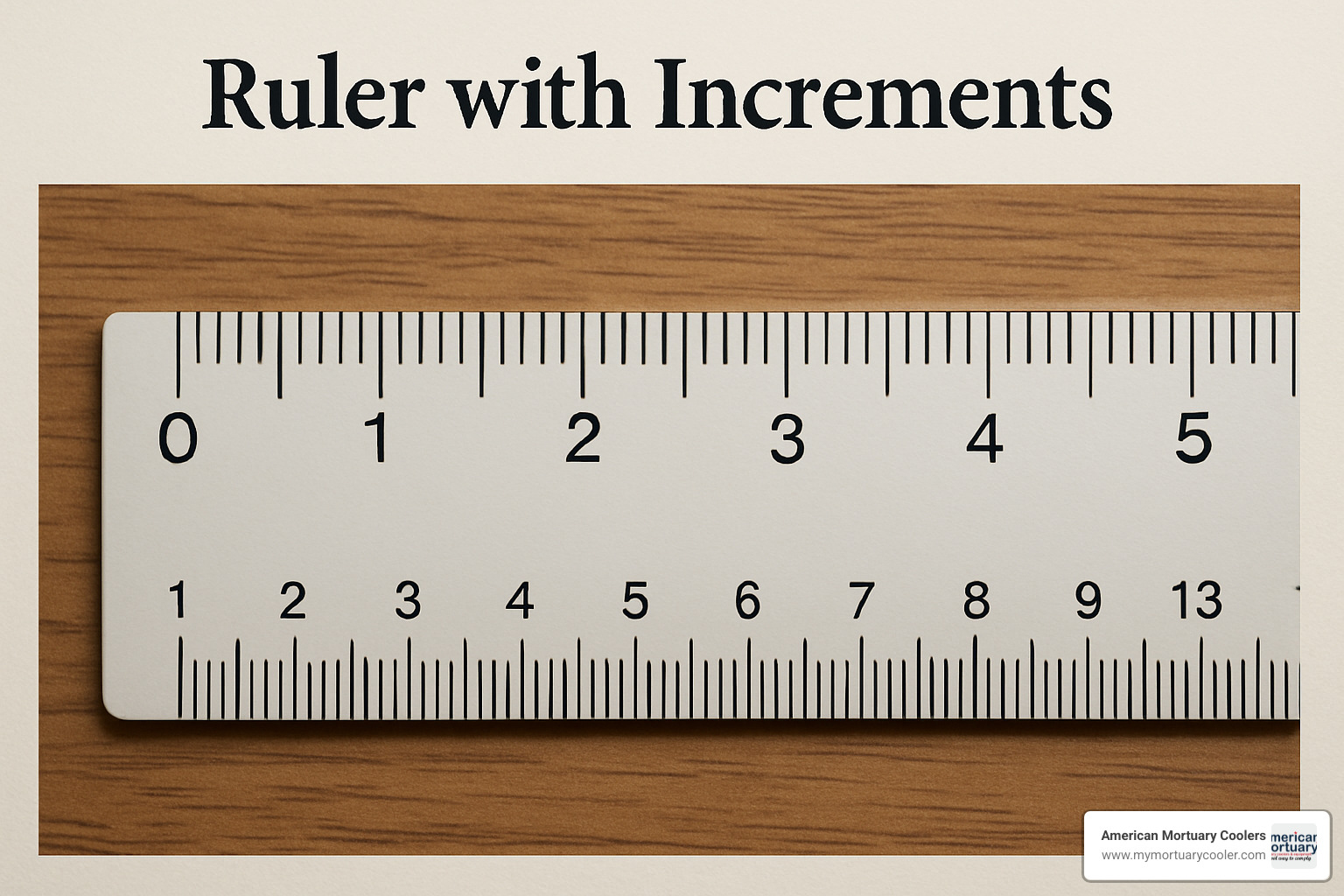
Built-In Conversion Charts and Decimal Equivalents
Premium rulers with increments often include built-in conversion charts printed right on the tool itself. These handy reference guides typically appear on the back of metal rulers or along the edges of wider models.
For professionals who regularly switch between measurement systems, these built-in references eliminate the mental gymnastics of conversion calculations. A glance at the back of your ruler tells you instantly that 5 mm equals 0.19685 inches, saving valuable time in busy workshop environments.
Beyond conversion charts, modern rulers often feature thoughtful physical improvements. Flush-end designs start the zero mark precisely at the ruler's edge, ensuring accurate measurements when butted against an object. Hang-holes let you store your ruler neatly on a workshop pegboard, while cork or non-slip backing prevents frustrating slippage during use. Some even include a magnification strip – a small built-in magnifier that makes reading those tiny increment marks much easier on the eyes.
Digital Rulers & Companion Apps
The measuring world has gone digital, with electronic rulers and smartphone apps bringing new capabilities to this ancient tool. Digital rulers feature LCD displays that show measurements in multiple formats with crystal clarity. With the press of a button, you can instantly convert between inches and millimeters, store multiple measurements in memory, or reset the zero point anywhere along the ruler's length.
Smartphone apps have taken this convenience even further. Your phone can now become a measuring device through camera-based measurement apps or augmented reality tools that let you "measure" objects just by pointing your camera at them.
Here at American Mortuary Coolers, we appreciate both traditional precision and modern innovation. While we love the convenience of digital tools, we still recognize that traditional rulers with increments offer best reliability for precision work, especially in laboratory settings where accuracy is non-negotiable.
For more insights into how we blend traditional quality with modern innovation in our equipment designs, you might enjoy reading The Ultimate Guide to Choosing the Right Wheelchair Stretcher.
Frequently Asked Questions about Rulers with Increments
What makes a ruler with increments more accurate than a tape measure?
Unlike flexible tape measures that can bend and stretch over time, rulers are rigid and maintain their shape. This solid construction eliminates one of the biggest sources of measurement error – flexing during use. When you need to measure something with precision, that rigidity matters tremendously.
High-quality rulers also feature precisely milled edges that provide a perfectly straight reference line. Combined with their fixed scale that's either printed or etched directly onto the solid surface, you get consistently accurate readings that tape measures simply can't match.
For detail work, many precision rulers offer increments as fine as 1/64-inch or 0.5mm – markings you rarely find on standard tape measures. Plus, quality rulers begin their measurement precisely at the edge (what's called "zero-start accuracy"), while tape measure hooks can wear or bend with use.
That said, tape measures still have their place! For anything longer than 24 inches, they're indispensable. But for those critical measurements under a foot or two, reaching for a good ruler with increments will give you the accuracy your project deserves.
How do I teach students to read 1/32-inch increments without confusion?
Teaching students to read those tiny 1/32-inch marks doesn't have to cause classroom headaches! Breaking down the learning process into manageable steps makes all the difference.
Start with the basics before diving into the details. Begin with whole inches, then gradually introduce half inches, quarter inches, and eighths before tackling 1/16 and finally 1/32. This progressive approach builds confidence and understanding at each step.
Visual learning works wonders here. Create enlarged ruler sections on worksheets where students can practice identifying specific measurements. Many teachers find that color coding different increment sizes helps students visually distinguish between them – perhaps blue for quarter-inches, red for eighths, and so on.
Hands-on practice is absolutely essential. Have students measure actual objects around the classroom and compare their readings. This real-world application helps cement the concept better than any worksheet alone.
When students understand why such precise measurements matter in real-world contexts like engineering or fine woodworking, they're often more motivated to master these skills.
Can one ruler handle both metric and fractional inch increments effectively?
Yes! Dual-scale rulers can absolutely handle both metric and fractional inch increments, though there are some practical considerations worth knowing about.
The main challenge with dual-scale rulers with increments is simply space. When you pack both measurement systems onto one ruler, each scale naturally gets less real estate, making the increments more crowded and potentially harder to read, especially in poor lighting.
That said, the convenience factor is huge. For most everyday applications – from school projects to basic DIY work – having both systems readily available outweighs these minor drawbacks. I keep a quality dual-scale ruler in my desk drawer and find myself using both sides regularly, especially when working on international projects or following instructions from different sources.
For professional applications where absolute precision is critical, separate dedicated rulers for each measurement system might be preferable. But for educational settings, offices, and general workshop use, a good dual-scale ruler provides excellent functionality without breaking the bank.
Conclusion
The humble ruler with increments is far more than just a simple measuring stick. It's a precision tool with centuries of refinement behind it, designed to meet specific needs across countless applications.
When I think about measurement tools, I'm reminded that the right ruler can make all the difference between a project's success or failure. Whether you're a student learning fractions, a craftsperson creating fine furniture, or an engineer designing precision components, your choice of ruler matters tremendously.
Here's what we've learned on our journey through rulers: First, increment systems matter - your choice between fractional, decimal, and metric should align with your specific needs. Second, materials make a huge difference - wood offers classic reliability, plastic provides safety and visibility, while metal delivers best precision and durability.
We've also seen how thoughtful safety features like beveled edges, rounded corners, and shatterproof materials transform rulers from potential hazards into classroom-friendly tools. And those advanced features? Built-in conversion charts, flush-end designs, and digital capabilities aren't just bells and whistles - they're genuine time-savers that expand what's possible with a single measuring tool.
Reading a ruler with precision isn't something we're born knowing how to do - it's a skill that improves with practice and proper technique. The more you work with rulers, the more intuitive those tiny marks become.
At American Mortuary Coolers, we understand precision measurement intimately. Based in Tennessee with locations throughout the United States, our team creates custom mortuary coolers and specialized equipment for the funeral industry. While our focus is different, we share with ruler manufacturers an appreciation for exactness and attention to detail.
Choosing the right ruler with increments ensures your measurements will be as accurate and useful as possible. For those interested in our specialized equipment and services, please visit our article on American Mortuary Coolers – refrigeration solutions.
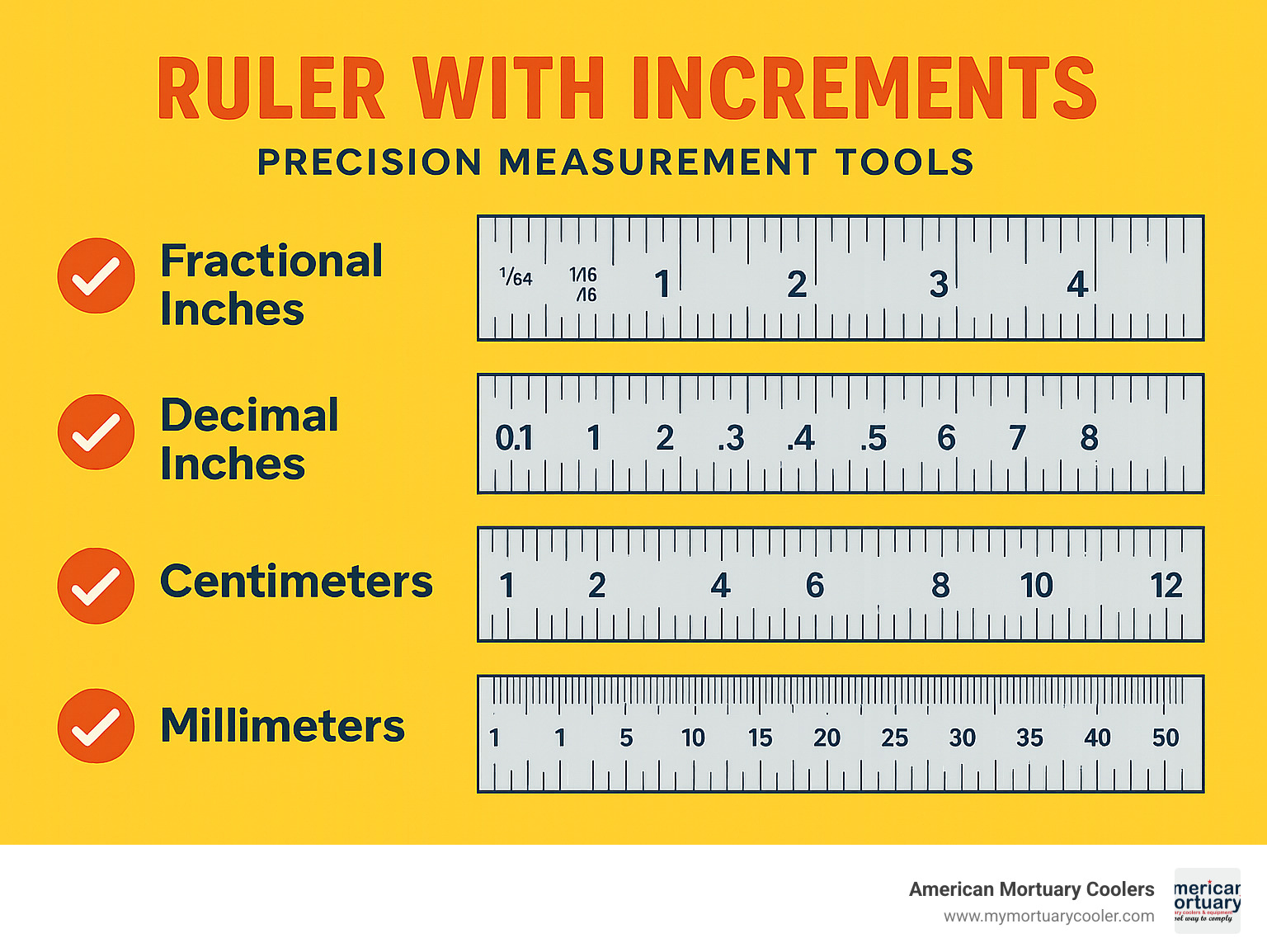
In measurement as in life, precision matters. Choose your tools wisely, and they'll serve you faithfully for years to come.



